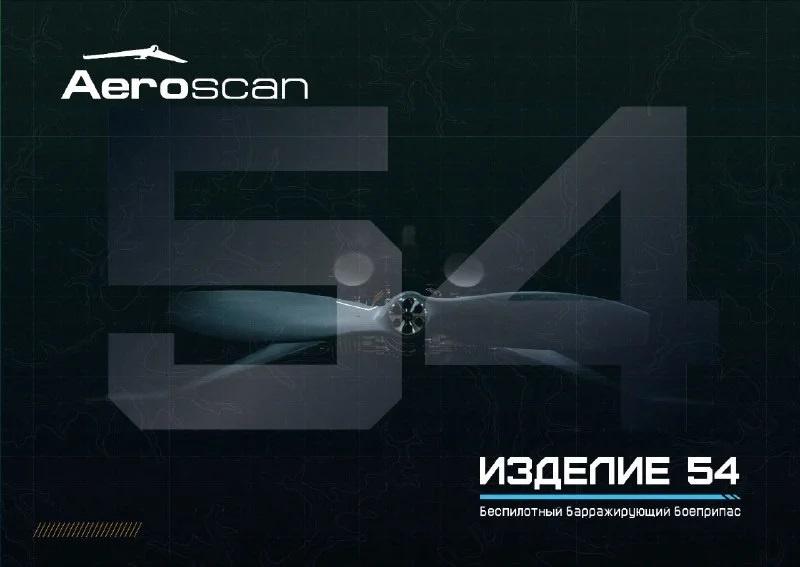Russia’s big Army 2023 Expo last week featured the expected flurry of announcements of new kamikaze drone projects. Many of these will be pure vaporware, a category in which Russia has long excelled, but some deserve to be taken more seriously. A weapon known as Izdelie 54 (‘Product 54’) may be significant simply because of who is making it.
A press release from the show gave minimal information:
“AEROSCAN at the international military-technical Forum Army 2023 announced a new model of long-range loitering ammunition with an enlarged warhead – ‘Product 54.’
The product is designed to destroy military equipment and manpower of the enemy, located at a considerable distance.
This model is an initiative development of the company, uses the latest artificial intelligence algorithms and is currently undergoing final tests before being put into production.”
As we have seen, numerous Russian companies are attempting to break into this market, as kamikaze drones or loitering munitions have been among Russia’s few successes during this war. The Lancet, a 25-pound drone with a 7-pound warhead has shown itself capable of knocking out artillery, tanks and other armored vehicles from 25 miles away. Its biggest issue seems to be targeting; numerous Lancet kills are actually dummies, and one recent video posted as a ‘success’ seems to show a Lancet destroying a Russian T-90M tank.
Meanwhile Russia continues to bombard Ukraine with 450-pound, Iranian-made Shahed-136 kamikaze drones and it attempting to started up a factory to mass-produce a Russian version under license. These drones have a range of several hundred miles.
What makes Product 54’s maker is Aeroscan, a company headed, at least in name, run by Nikita Zakharov. He happens to be the son of Alexander Zakharov, a businessman with a controlling 50.85% interest in Zala Aero Group which makes the Lancet. The rest of the shares are owned by the Kalashnikov Concern, and Lancet is often referred to as a Kalashnikov product. Alexander Zakharov’s daughter Maria also has her own drone company, Orion.
Aeroscan has been very much below the radar, with virtually no information about their projects, they make a long-range reconnaissance drone known as Z-20 but it is not known whether this is in production or service.
It seems highly unlikely that Nikita Zakharov, would go into competition with the family’s main business. (Incidentally, he appears to have been to Oxford University and owns luxury real estate in London). The new Product 54 is more likely a very long-range drone intended to compete with the Shahed. As we saw previously, the Russian company attempting to make Shaheds may have some difficulty, and with Zakharov family know-how and connections Aeroscan may be able to make up the shortfall and tap a rich vein of procurement cash from Russia’s Ministry of Defence.
We have a good idea the drones will be made. On December 30th last year, the tenants of the Italmas shopping mall, in the city of Izhevsk 700 miles east of Moscow all had their leases terminated. These included a supermarket, several fashion outlets, a pizza parlor and a former McDonalds. A local news investigation found that the mall has been acquired by Aeroscan, apparently for the production of drones. The city is no stranger to the arms business. Its biggest tourist attraction is the Kalashnikov Small Arm’s Museum Exhibition Complex, and it happens to be Alexander Zakharov’s home town.
In August 2020, Alexander Zakharov suggested that shopping malls selling foreign brands should be shut down and repurposed for drone production. It seems as though he was serious.
This sounds like the set-up for a new Russian reversal joke: “In America you go to shopping mall to get new gadgets. In Russia, new gadgets come from the shopping mall to get you!”
…Except this is deadly serious. But how dangerous is it?
“If this Izdelie 54 is a ‘long-range’ drone, it will probably have to compete more with Shahed, but it all depends on specs,” Samuel Bendett an expert Russian drones and adviser to both the CNA and CNAS, told Forbes. “It’s possible that this new drone will fill the gap between Lancet and Shahed capability – with a range of 80-200km, or may be designed for even longer ranges.”
Of interest is the claim that the 54 ‘uses the latest artificial intelligence algorithms’. The Lancet is notable for having a U.S.-made Jetson TX2 processor is optimized for neural networks to giving drones AI capability, and which is believed to help the Lancet to lock on to targets identified by the operator. The new drone may benefit from more recent and powerful smuggled processors, and the AI algorithms may be used either to aid in navigation, targeting or both. Algorithms links to a drones camera can spot landmarks and navigate when GPS is jammed, and machine learning can identify targets without human intervention.
This capability gives a small drone the ability to hit targets with high precision, making it a more dangerous weapon than a cruise missile with a much larger warhead but less reliable guidance. And at tens of thousands of dollars rather than millions, kamikaze drones give Russia a sustainable way to continue the war.
“What this shows is the growing need for a relatively cheap, capable loitering munition in this war,” says Bendett, noting that Russian volunteer organizations like Project Archangel and Oko Design Bureau are also now designing their own loitering munitions with a long range.
Naturally the war of long-range strike drones cuts both ways. And Italmas shopping mall may now be on the target list.
Read the full article here





